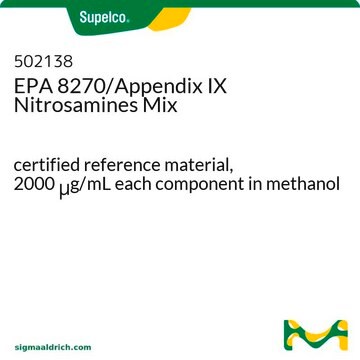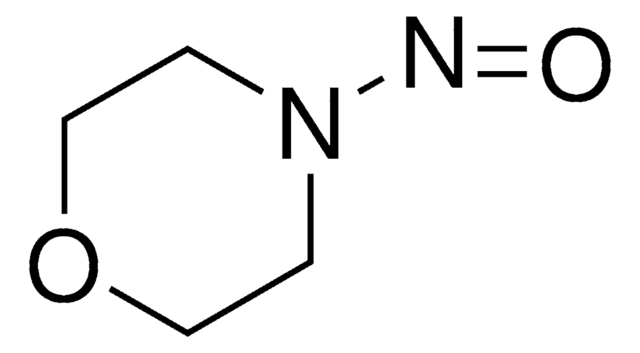442687
N-Nitrosodiethylamine
analytical standard
Sinônimo(s):
Diethylnitrosamine
About This Item
Produtos recomendados
grau
analytical standard
Certificado de análise (CofA)
current certificate can be downloaded
embalagem
ampule of 1000 mg
técnica(s)
HPLC: suitable
gas chromatography (GC): suitable
p.e.
177 °C (lit.)
densidade
0.95 g/mL (lit.)
aplicação(ões)
cleaning products
cosmetics
environmental
food and beverages
personal care
Formato
neat
temperatura de armazenamento
2-30°C
cadeia de caracteres SMILES
CCN(CC)N=O
InChI
1S/C4H10N2O/c1-3-6(4-2)5-7/h3-4H2,1-2H3
chave InChI
WBNQDOYYEUMPFS-UHFFFAOYSA-N
Procurando produtos similares? Visita Guia de comparação de produtos
Aplicação
Produtos recomendados
Palavra indicadora
Danger
Frases de perigo
Declarações de precaução
Classificações de perigo
Acute Tox. 3 Oral - Aquatic Chronic 3 - Carc. 1B
Código de classe de armazenamento
6.1C - Combustible acute toxic Cat.3 / toxic compounds or compounds which causing chronic effects
Classe de risco de água (WGK)
WGK 3
Equipamento de proteção individual
Eyeshields, Faceshields, Gloves, type ABEK (EN14387) respirator filter
Escolha uma das versões mais recentes:
Já possui este produto?
Encontre a documentação dos produtos que você adquiriu recentemente na biblioteca de documentos.
Os clientes também visualizaram
Protocolos
US EPA Method 8270 (Appendix IX): GC Analysis of Semivolatiles on Equity®-5 (30 m x 0.25 mm I.D., 0.50 μm)
Nossa equipe de cientistas tem experiência em todas as áreas de pesquisa, incluindo Life Sciences, ciência de materiais, síntese química, cromatografia, química analítica e muitas outras.
Entre em contato com a assistência técnica








